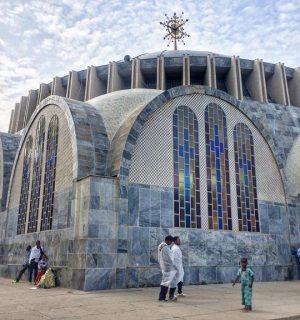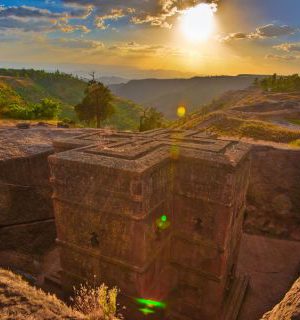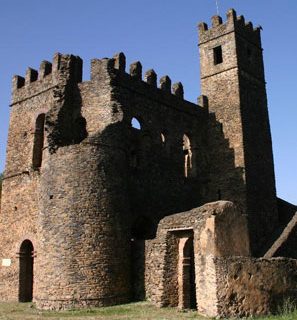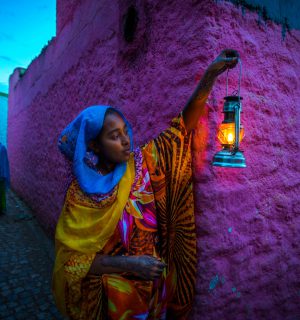Historical Tour
Axum
![]()
Axum is both the name of an Empire and a city, the root of the Axumite Empire was the proto Axumite civilization flourished between 2000 – 1000 B.C By about 1000 BC the synthesis of proto- Axumite civilization and immigrants from south Arabia resulted in the emergence of Axumite Empire and civilization that flourished until 10th century AD.
The city of Axum had been the capital of the Axumite Empire. The significance of the city lies in its historic places and monuments. There are ancient obelisks and pre Christian places which attesting at a high level of advancement in art and architecture. The finest of these obelisks, more commonly referred as “stelae” stand in the so-called, “park of stelae”. Here there are many giant obelisks carved from solid granite.

The most massive of these is believed to have fallen to the ground more than thousand years ago it measures 33.5 meter’s. It is thought to be the largest single piece of stone ever successfully quarried and erected in the ancient world. The fallen stelae is hewn to mimic a high, slender building of thirteen stories, each storey with representations of windows and other details. At the base can be discovered a false door complete with a knocker and lock, all perfectly carved in stone. Another fallen but smaller and unbroken obelisk was stolen during the Italian occupation of 1935- 41, transported with difficult and re-erected in Rome at Piazza di Porta. There has been effort by Ethiopian Governments for its return since the period of Emperor Haile silasse.
The third decorated monolith still remains in the stelae park. This stelae is 24 meters high and is topped with a curved headpiece shaped like a half moon. Several other stelae of varying sizes stand ranged around this refined monument. In addition to this there are lots of historical objects in the city of Axum. One can visit the oldest church in Ethiopia, the church of saint Mary of Zion. The city of Axum is literally a museum without walls, filled with remains left by history and it allows visitors to return to the past. In the surrounding of the city of Axum too there are many sites with historical significance. The monastery of Debre Damo and the pre Axumite center of Yeha are some of them.

Lalibela
![]()
Lalibella, the site of 11 spectacular rock- hewn churches is an important historical attraction in Ethiopia. King Lalibella (r.1180 – 1221) was one of the kings of the Zagwe Dynasty which flourished after the fall of the Axumite Empire in the 10th century A.D. According to some sources king Lalibella constructed the churches in an attempt to create the second Jerusalem at the heart of Ethiopia.
The area on which the churches are found covers about two square kilometers. The churches were excavated in the red volcanic stuff of mount Abuna Joseph in massive rectangular blocks. Out of these blokes the craftsmen chiseled the ceilings and walls 30 to 50 feet high, floors on varying levels, individual rooms, windows, columns and arches. They surrounded the churches with an extensive system of drainage ditches.
The eleven churches share common architectural features, including basilica-informed construction, columns, altars, windows, relief, and paintings, showcasing the skill of masons and sculptors.
Rock-hewn churches in Ethiopia are essentially Ethiopian, with no Egyptian influence. They are found in built-up edifices from the Axumite period. Other rock-hewn churches in Ethiopia differ in architectural style, detached from mountains, and elaborately shaped. The closest comparable church is the Dravidian temple, kailas, in Ellora, Hyderbad.
The rock-hewn churches of Lalibella, Ethiopia, are a fascinating and remarkable testament to human faith. Portuguese priest Francisco Alvarez visited the churches in 1520 and wrote that he swore by God that all his writings were the truth, leaving it for others to verify. Today, many tourists continue to share this belief, using different language.
Visitors can explore numerous rock-hewn churches in Lalibella and Tigray, some of which are inaccessible and can be visited by walk, mule, or rope.
Gondar
![]()
Gondar was the capital of Ethiopia between the 17th and 19th century. It became the royal capital in 1636, in the time of Emperor Fasiledes, who built the first and most famous of the castles.
The establishment of the city marked a major turning point in Ethiopia’s long history. For the previous half millennium the country had been with out long-enduring capital and its rulers had indeed spent much of their times marching from camp to camp until their last resting place. The emergence of Gondar marked the end of this era of moving capitals for the city remained the center of Ethiopian government until the second half of the 19th century.

Emperor Fasiledes erected fine two storied castle at Gondar. It is marvelous building, worthy of admiration, and the most beautiful of the outstanding wonders. Another building constructed by Fasiledes was the Bathing place now called after him. The pool is still filled with water each year for the annual Timket, or Epiphany, celebrations. The development of the city which had been begun by Fasiledes was continued by his son, Yohannes I and grandson Iyasu I. These and other kings constructed other castles.
In the hills North West of the city of Gondar, was also site of numerous impressive buildings. Mintwab, the mother of Iyasu II was instrumental in the construction of these palaces. The palace is one of the most attractive of the Gondar buildings.
Besides a number of places, the town and its surrounding also contain some 44 churches. On the other side of the town of Gondar, crowning a hill- top and surrounded by its wall and grove of trees, found the church of Debre Berehan Silassie. Built by Iyasu I in the 17th century, it is perhaps the most perfectly preserved church since those days. Its main interest now rests in the interior paintings. The walls and ceiling are decorated with frescoes of angels, saints and devils. The paintings, despite the passing of centuries, seem to burst with exuberant energy and with extravagant life and color.

Bahar Dar
![]()
Bahar Dar is a fast growing town situated on the shore of Lake Tana. It has many things of interest for visitors, such as its colorful market. This market is renowned for its weavers, baskets, and wood works. But Bahar Dar is more important for travelers as a springboard to visit at least two of the countries attractions; the Blue Nile Falls and Lake Tana.
About 30 km away from Bahar Dar there is the majestic Blue Nile Falls where waters of the Nile plunge over a cliff that is 50 meters long and 400 meters wide. It is breath taking to view the falls breaking the smooth, majestic edge of the rolling Nile in to a thundering cataract of white water foaming and boiling down a dark cliff. The landscape around the falls is covered by a delight full combination of tropical and mountainous vegetation there is also an exuberance of bird life.
Lake Tana, the largest in Ethiopia is an attraction both with historical and natural significance. This lake can be put in first place out of all lakes in the country not only in its size but also in its history and treasures. About twenty of the islands in Lake Tana have monasteries, some of them dating back to the fourteenth century; many of these monasteries have priceless manuscripts, parchments, scrolls and paintings.
Harar
![]()
Harar is an ancient walled Ethiopia city. Possessing as many as 99 Mosques, Harar is considered to be the third holy city of Islam. In Ethiopia as Axum was the window for Christianity, Harar is the same for Islam. Historically, Harar has been a controversial issue among historians. To some the establishment of Harar goes back as the 7th century and to others to the 9th century.
The wall of Harar is locally known as the Jegol, The old city cramped within its ancient walls, the new extending freely. The walls are believed to have commenced by Ibn al Wazir Mujahid Nur, a nephew of Ahmed Gragn, who is said to have dug a defensive trench around the town. The wall is pierced by six gateways, five of them derived from ancient times, though the original gates are no more. Two other were added by Ethiopian Government, but one of the later was destroyed by the Italians.

Harar as a modern urban center has different kinds of people. These people have different language and different ways of dressing. The people are known as the kotu Oromo, Harari, Somali and Amhara.
One important attraction in Harar is the market place. Just outside of the Shoa gate of the wall of Harar is a large sloping area devoted to daily marketing. People come from all around Harar to participate in the market. Much of the trading in the market places is carried on by women, who like to dress their hair in twin buns back of each ear and who are addicted to wearing shawls of brilliant orange or red. The men prefer to wear sarong-like skirts.
Harar is the only city in the world where hyenas are fed by human hand. There is a place in Harar along the wall of the old city where at night one can see ” Hyena men” who have their pets among these scavengers and call them forth to be fed by hand.
The palaces of Emperor Menelik Ras Mekonnen’s Mausoleum and palace, the ancient Jami mosque and the church of Medhani Alem are some of the attractions worth visit. In addition there are a number of caves in Harar area these caves are dated back to prehistory and are known for their paintings.
